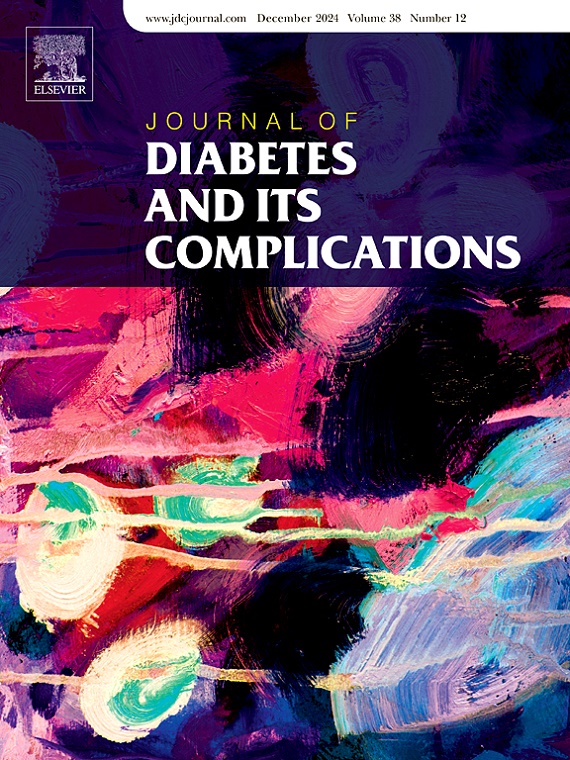残留的 C 肽与 1 型糖尿病患者新的和持续的低血糖意识受损有关
IF 2.9
3区 医学
Q3 ENDOCRINOLOGY & METABOLISM
引用次数: 0
摘要
目的描述荷兰 1 型糖尿病生物标志物队列(NCT04977635)中低血糖意识受损(IAH)随时间推移而发生的变化,并确定与这种变化相关的因素。方法对 C 肽为 300 pmol/L 的 1 型糖尿病患者进行前瞻性队列研究,这些患者完成了 Clarke 问卷调查,以确定基线和 2 年后的 IAH 状态。意识状态变化的定义和比较如下:正常意识(NAH)不变与IAH不变、新的IAH与IAH逆转。多变量逻辑回归模型的拟合采用了前向和后向逐步选择法,以 0.10 为 P 值临界值,并采用 AIC 标准进行逐步后向选择。IAH的基线发病率为17%,2年后为20%。新IAH和IAH逆转的发生率分别为9.5%和31%。C 肽每增加 2.7 倍,IAH 的几率就会降低 58%。结论较高的C肽水平对新发IAH具有保护作用,随着时间推移,BMI的增加与IAH的逆转有关。本文章由计算机程序翻译,如有差异,请以英文原文为准。
Residual C-peptide is associated with new and persistent impaired awareness of hypoglycaemia in type 1 diabetes
Aims
To describe the change in impaired awareness of hypoglycaemia (IAH) over time and to identify factors associated with this change in the Dutch Type 1 Diabetes biomarkers cohort (NCT04977635).
Methods
A prospective cohort of type 1 diabetes patients, with C-peptide <300 pmol/L, who had completed the Clarke questionnaire, to determine IAH status, at baseline and after 2 years. Changes in awareness status were defined and compares as follows: unchanged normal awareness (NAH) versus unchanged IAH, new IAH versus reversal of IAH. Multivariate logistic regression models were fitted using forward and backward stepwise selection using a 0.10 P-value cut-off, and stepwise backward selection using AIC criteria.
Results
A total of 431 out of 611 participants were included. The baseline prevalence of IAH was 17 % and 20 % after 2 years. The incidence proportion of new IAH and reversal of IAH were, 9.5 % and 31 %, respectively. For every 2.7-fold increase in C-peptide, the odds of IAH decrease by 58 %. A 1-unit increase in BMI over the 2-year follow-up period is associated with a 5.27-fold increase in the odds of reversing IAH.
Conclusions
Higher C-peptide levels are protective against new IAH, and an increase in BMI over time is associated with the reversal of IAH.
求助全文
通过发布文献求助,成功后即可免费获取论文全文。
去求助
来源期刊

Journal of diabetes and its complications
医学-内分泌学与代谢
CiteScore
5.90
自引率
3.30%
发文量
153
审稿时长
16 days
期刊介绍:
Journal of Diabetes and Its Complications (JDC) is a journal for health care practitioners and researchers, that publishes original research about the pathogenesis, diagnosis and management of diabetes mellitus and its complications. JDC also publishes articles on physiological and molecular aspects of glucose homeostasis.
The primary purpose of JDC is to act as a source of information usable by diabetes practitioners and researchers to increase their knowledge about mechanisms of diabetes and complications development, and promote better management of people with diabetes who are at risk for those complications.
Manuscripts submitted to JDC can report any aspect of basic, translational or clinical research as well as epidemiology. Topics can range broadly from early prediabetes to late-stage complicated diabetes. Topics relevant to basic/translational reports include pancreatic islet dysfunction and insulin resistance, altered adipose tissue function in diabetes, altered neuronal control of glucose homeostasis and mechanisms of drug action. Topics relevant to diabetic complications include diabetic retinopathy, neuropathy and nephropathy; peripheral vascular disease and coronary heart disease; gastrointestinal disorders, renal failure and impotence; and hypertension and hyperlipidemia.
 求助内容:
求助内容: 应助结果提醒方式:
应助结果提醒方式:


